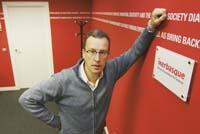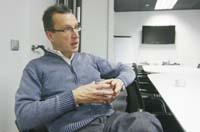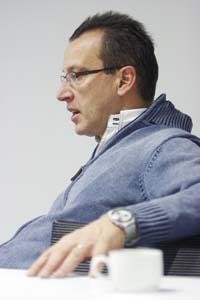Enrike Zuazua: "The most important tool in mathematics is researchers"

It is the second Centre of Excellence in Basic Research (BERC) created by Ikerbasque and dedicated to research in Applied Mathematics. This specialty, born after World War II, with the first efforts in the development of computing, has become important thanks to advances in aviation, space travel and telecommunications.
In the Basque Country there is a rich network of technological centres, following the tradition of the traditional industrial activity of the Basque Country. The leap from these technological centers to the academic world is often intense. The BCAM centre aims, among other things, to complete this intermediate gap. One of my main tasks will be the implementation of an innovative model in the center. For this, on the one hand, we will carry out a quality management of the center, providing the most current and better tools that are used worldwide and forming a high level scientific team. On the other hand, through the experience and knowledge I have collected so far, we will launch several lines of research.
To date we have identified three main lines of research, including two other lines that could be consolidated in the future. But we don't want the center to grow too fast. We want to work as a team, dealing with different topics and areas. In fact, many new ideas can emerge in this collaboration. That is, we will maintain the creativity and freedom of each researcher in organizing and deciding the investigations, but we will try to group them and coordinate them in groups to achieve greater success. And the team creates a different skill to face great challenges. The most important tool of mathematics are researchers.
In addition, this collaboration generates a new environment and that is why I emphasize the importance of this model of operation. On the contrary, in general, mathematicians tend to sit in front of the computer, take the pencil and paper and put in a lot of hours without much contrasting the work with the rest of researchers. We want researchers who come to this mathematical research center to have the feeling of having come to a real active research center. We want to open the world the center as a special place to carry out mathematical research.

On the one hand, we will work on partial derivative equations, numerical analysis and control and optimization disciplines. Especially in that line. In a specific function with several independent variables, partial derivative equations allow analyzing the relationship between variables. Following Newton's model, they have been used to analyze complex phenomena involving space and time. However, this use has evolved over time and, although previously used, for example, to study the diffusion of sound and heat, the calculation of structures and the aerodynamics of vehicles, today they are used as reference models in the field of neurosciences and biology, among others. Numerical analysis translates analytical mathematical understanding of the human being into computer language. Control and optimization disciplines are created to achieve the most appropriate configuration of a certain mechanism or process.
On the other hand, the Biscayan mathematician David Pardo performs a high numerical simulation. What is meant is that the methods you use and the codes you generate are very reliable. They are said to converge exponentially in mathematics. That is, they are lighter than other methods. With this agility you can analyze big and complex problems. Advanced numerical methods are used to simulate and analyze different physical phenomena (with the help of large computers). For example, they are used to simultaneously simulate aerodynamics and acoustics of an aircraft, to locate hydrocarbons in oil reserves or to detect tumors in the human body, jointly analyzing the results obtained in magnetic resonances and ultrasound.
Finally, the gipuzkoano Urtzi Ayesta has just arrived in February to direct a line of research on networks or network communication systems. The main scope of this line will be the Internet infrastructure, its applications and wireless networks. It will work on new Internet models to streamline communication and will try to predict possible errors and/or attacks to develop control strategies to combat them. It immerses itself in a complex world that we do not see.
Yes. We are developing lines of research on materials science and biomatematics. Two young researchers from Great Britain, Carlos Mora Corral and Philipp Getto, respectively, work on these lines. Our goal is to work these lines in a stable way in the future.
Materials science has a great impact on our daily lives and on different technologies. The mathematics in this regard is very deep, using analysis and geometry in a very precise way to analyze the fine characteristics of the new materials and explain their defects or fatigue.

Biomatemática integrates mathematics and medicine, mathematics and nature, mathematics and biology... The challenges are growing. The work developed so far by Philipp Getto is focused on the dynamics of the populations, analyzing the usual problems as the evolution of a living being in certain environmental conditions. This has an application, for example, when measuring the health of our natural heritage. Through various mathematical equations it is a matter of understanding how two or more communities grow in certain environmental conditions, how they expand, how often they face to endanger their future, etc.
In recent years I have worked as a professor at several universities, so I have received up close how to combine the usual debate, education and research in many universities. Being a professor in universities, this lack is very noticeable. Research is conducted at universities, but centres such as BCAM offer more possibilities and facilities to focus on research. In fact, with the management of projects in our hands, new avenues are underway to face new challenges. This type of center brings another agility to research. In this sense, we have chosen as the motto of our center "Mathematics on the other hand". It is inspired by a poem by Bernardo Atxaga. It recognizes the intention of going to new challenges, from Euskal Herria to the world, working traditional mathematics.
Buletina
Bidali zure helbide elektronikoa eta jaso asteroko buletina zure sarrera-ontzian











